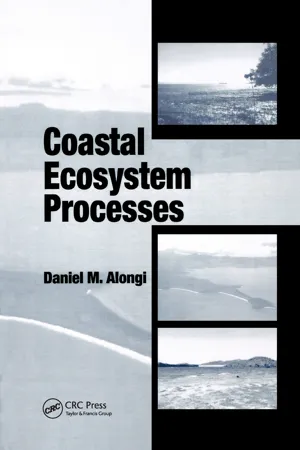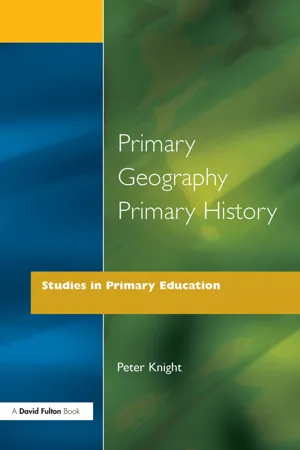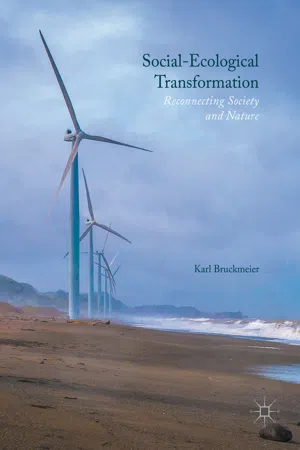Coasts Geography
Coastal geography is the study of the dynamic interface between land and sea. It encompasses the physical processes, landforms, ecosystems, and human activities that shape and are shaped by coastal environments. Key concepts include erosion, deposition, coastal landforms, sea level change, and the impact of human activities on coastal areas.
6 Key excerpts on "Coasts Geography"
- Gerd Masselink, Michael Hughes, Jasper Knight(Authors)
- 2014(Publication Date)
- Routledge(Publisher)
...CHAPTER 1 COASTAL SYSTEMS AIMS This chapter outlines how the coastal zone can be defined and discusses the properties and characteristics of systems, highlighting the importance of sedimentary processes and concepts such as self-organisation. Consideration of systems is useful because it provides a framework by which the dynamic behaviour of geomorphological processes and landforms can be understood. 1.1 Introduction This book is about coastal processes and geomorphology. The spatial boundaries of the coastal zone as considered in this book are defined in Figure 1.1 and follow the definitions set out by Inman and Brush (1973). The upper and lower boundaries correspond to the elevational range over which coastal processes have operated during the Quaternary period, and include the coastal plain, the shoreface and the continental shelf. During the Quaternary (from 2.6 million years ago until present), sea level fluctuated over up to 135 m vertically due to expansion and contraction of ice sheets and warming and cooling of the oceans. The landward limit of the coastal system therefore includes the coastal depositional and marine erosion surfaces formed when sea level was high (at or just above its present-day position) during global warm periods. The lowest sea levels, during global cold periods, placed coastal processes close to the edge of the continental shelf. The seaward limit of the coastal system is therefore defined by the continental shelf break, which typically occurs in water depths of 100–200 m. Changes in global climate during the Quaternary markedly shifted the position of the coastal zone, changing coastal geography particularly in areas with extensive shelves (Case Study 1.1). Many of today’s coastal landscapes reflect their Quaternary (and older) geological inheritance, and are responding dynamically to human activity in the coastal zone and ongoing global warming...
- eBook - ePub
- John Roff, John Roff(Authors)
- 2013(Publication Date)
- Routledge(Publisher)
...Regions of the coastal zone may be dominated by one or more of a set of physical processes, on a range of time scales, including wave activity, tidal range and currents, and river inputs (Figures 11.2 and 11.3). The coastal zone is in a constant state of flux and modification over time (see Figure 11.3), and is subject to a variety of influences. Periodic or aperiodic catastrophic events, such as storms and hurricanes, can have particularly profound and unpredictable effects, of much greater significance than seasonal or annual events, that may locally or regionally change the entire character of the coastal zone. In this respect, any conservation initiative in the coastal zone should consider the time-frame, or longevity, of the geomorphological structures being evaluated. Questions related to how coasts originate, how likely they are to evolve and how long they will last are vital to considerations of regional ecological significance. Table 11.3 Selected geomorphic and biogenic units and habitats of the coastal zone Zone Geomorphic unit Primary biotope or biogenic unit Habitat type Supra-tidal (backshore) Rocky headlands/cliffs Rocky shore Beaches Coastal dunes Coastal dune Lagoon Marsh Sand bars/spits Barrier islands Supra/intertidal Salt marsh Salt marsh Salt marsh Delta Mangroves Intertidal (foreshore) Rocky shore Tidal pools Sandy beach Mud-silt flats Intertidal/sub-tidal Inlets Coves Rocky, sandy shores Rocky, sandy shores Bays Sand, mud Sand, mud Estuaries Sand, mud silt Sand, mud silt Sandy banks Sub-tidal (offshore) Ridges Coral reef Fringing Reefs Barrier Banks Atoll Gullies Kelp forest Canyons Seagrass...
- eBook - ePub
The Geography of Tourism and Recreation
Environment, Place and Space
- C. Michael Hall, Stephen J. Page(Authors)
- 2014(Publication Date)
- Routledge(Publisher)
...Implementation strategies often fail to recognise the interconnections that exist between agencies in trying to manage environmental issues, particularly when, as in the case of the relationship between tourism and the environment, responsibilities may cut across more traditional lines of authority. Therefore, one of the greatest challenges facing coastal managers is how to integrate tourism development within the ambit of coastal management, and thus increase the likelihood of long-term sustainability of the coast as a whole. Nevertheless, solving such dilemmas will clearly be of importance to many countries in the region, which has a substantial emphasis on marine and coastal tourism, particularly when environmental quality becomes another means to achieve a competitive edge in the tourism marketplace. The coastal environment has a great deal of potential for cultural and social geographers to explore the value and role of tourism and recreation in these leisure places. There is also a role for applied geographers to combine their skills with those of planners, to understand, explain and develop planning measures to safeguard these threatened environments. The coastal environment is one of the best examples of how geographers can harness their ability to construct a holistic understanding of the human and physical environment in a coastal context, where the interactions, impacts and measures needed to ameliorate negative effects can be addressed. The period since 1970 has not, with a few notable exceptions, seen the geographical fraternity rise to this challenge and lead the coastal research agenda in a tourism and recreational context. One would hope, indeed expect, geographers to engage their skills, building on a long tradition of the geographer’s involvement with the recreational and tourism use of the coast. Further reading For general overviews of marine and ocean tourism, see: Garrod, B. and Wilson, J.C...
- eBook - ePub
- Daniel M. Alongi(Author)
- 2020(Publication Date)
- CRC Press(Publisher)
...Chapter 6 T HE C OASTAL O CEAN I. T HE C OASTAL Z ONE 6.1 INTRODUCTION The interface between land and the open sea — the continental margin — occupies only about 8 and 0.5%, respectively, of the surface area and volume of the world’s ocean. However, the high productivity of coastal seas equates to nearly 30% of total net oceanic primary production and at least 90% of the global fish catch. 407 This high productivity is driven by nutrient inputs from rivers and groundwater, upwelling, exchanges at the continental shelf edge, and atmospheric inputs. The coastal ocean acts as a highly efficient trap for materials from land. A recent estimate suggests that >90% of river-derived materials, including trace metals and pollutants, are retained within deltaic and inner shelf areas. 408 This figure is an overestimate as it ignores the role of tropical riverine export to the ocean margin, but the tight coupling at the land-sea boundary reveals how crucial the coastal ocean is for estuarine and marine food chains, including fisheries, and for the cycling of elements. Most of our concepts of how the coastal ocean functions arose from the disproportionate research expended within coastal plain estuaries and the adjacent nearshore zone in temperate seas. More recent efforts to understand the role of the tropical coastal ocean, physical-biological interactions, and the atmosphere have begun to broaden our perspective of how coastal seas contribute to the world ocean. 6.2 THE COASTAL OCEAN DEFINED The traditional notion of the coastal ocean as being defined from the high-water mark on shore to the shelf break is essentially correct but ignores the fact that a dynamic continuum exists between land and the open sea. Figure 6.1 illustrates the main boundaries of the coastal ocean...
- eBook - ePub
- Peter Knight(Author)
- 2013(Publication Date)
- Routledge(Publisher)
...The locality should also be seen in the context of the home region, thereby introducing the concept of ‘regions’. Similarities and differences with other areas studied should be brought out and the issue of change should also be woven through the work. The interaction of weather, landscape and wealth on people’s lives is to be studied in the developing country. The physical geography involves them learning about a number of features (beach, river, valley), erosion and deposition processes, water courses, weather conditions in different parts of the world, vulcanology, seismology, and the nature of different soils. Settlements and their functions are associated with ideas explaining different population densities and migration and transport patterns, with the most advanced children being encouraged to consider the factors which make for change in human geography, alongside elementary locational theory. They are not so explicitly invited to consider the values issues in the environment, although there is considerable emphasis on ways of improving the locality. Global environmental issues get scant attention. Criticisms of this curriculum remind us that it is simply one view of geography (e.g. Catling, 1990b; Graves et al, 1990). A vocal criticism has been that geography can be seen very much as the study of human behaviour, and so it is necessarily, primarily concerned with human values, firstly, in order to make sense of and to understand human action, and secondly, in order to help students reflect upon their own values and the sort of world which they wish to live in (Fisher and Hicks, 1985; Pike and Selby, 1988; Hicks and Steiner, 1989). This curriculum is thought to have pushed values issues to the margins...
- eBook - ePub
Social-Ecological Transformation
Reconnecting Society and Nature
- Karl Bruckmeier(Author)
- 2016(Publication Date)
- Palgrave Macmillan(Publisher)
...A paradigmatic case is the Bay of Bengal in South Asia, the largest bay of the world, where the densely populated coasts are the home of about 40 % of the global population, mainly poor. This coast and the inhabitants are highly vulnerable to climate change (Samarakoon 2004). As a consequence of climate change, the management of coastal resources need to be rethought; this requires the integration of the perspectives of resilience and sustainability. Weinstein et al. (2007 : 43) describe the challenges of sustainable coastal management in the twenty-first century as sharing of space and resources between humans and other species, as conflict mitigation, consensus building, sacrifice, and compromise. In some regards, the situation in coastal areas is similar in all countries. Coastal landscapes are the preferred human habitats; two-thirds of all megacities are located at the coast. The global economy, global transport, and communication are strongly dependent on coastal cities and ports. In all continents, the population in coastal areas increases. Duxbury and Dickinson (2007 : 319) describe the situation demographically: approximately 41 % of the world’s population is living not more than 100 kilometres away from the coast: in 1990, 2 billion people and in 2000, 2.3 billion people. In 2025, the number is expected to be 3.1 billion people (Duxbury and Dickinson 2007 : 319). Because of the concentration of natural resources in coastal waters, the coastal ecosystems are important as life-supporting systems. Ecologically seen, coastal areas are vulnerable to climate change and sea level rise, storms, floods, earthquakes, and tsunamis. People continue to move to the coasts, although disasters increase and the impacts of climate change and sea level rise can already be experienced. After the devastation of New Orleans through Hurricane Katrina in August 2005, people moved back in the city and continued to live as usual...





